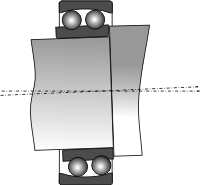
Back Diyircəkli yastıq Azerbaijani Kuglloga BAR بۆڵبەرینگ CKB Kuličkové ložisko Czech Pêl-feryn Welsh Kugleleje Danish Kugellager German Rodamiento de bolas Spanish Errodamendu boladun Basque بلبرینگ Persian




A ball bearing is a type of rolling-element bearing that uses balls to maintain the separation between the bearing races.
The purpose of a ball bearing is to reduce rotational friction and support radial and axial loads. It achieves this by using at least two races to contain the balls and transmit the loads through the balls. In most applications, one race is stationary and the other is attached to the rotating assembly (e.g., a hub or shaft). As one of the bearing races rotates it causes the balls to rotate as well. Because the balls are rolling, they have a much lower coefficient of friction than if two flat surfaces were sliding against each other.
Ball bearings tend to have lower load capacity for their size than other kinds of rolling-element bearings due to the smaller contact area between the balls and races. However, they can tolerate some misalignment of the inner and outer races.
Common ball bearing designs include angular contact, axial, deep-groove, and preloaded pairs. The balls in ball bearings can also be configured in various ways. Ball bearings are used in a wide range of applications, some of which include skateboards and centrifugal pumps.